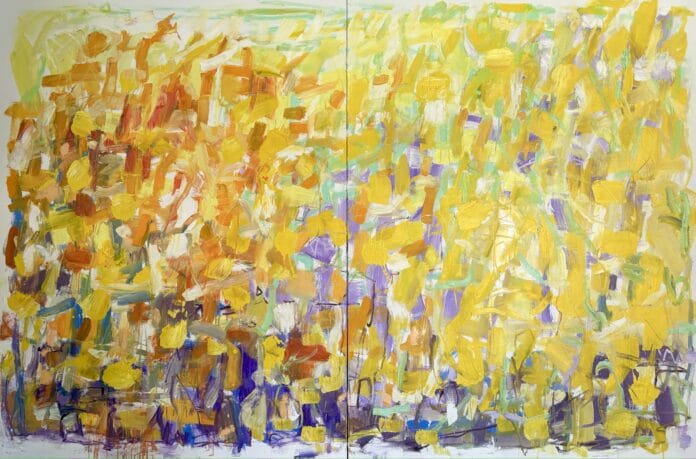Pien de Haas worked for about twenty-five years as a nuclear medicine physician. Her in-depth knowledge of molecular imaging and the physical processes in the human body forms the basis for her view on life. She perceives the human body not only as a biological structure but as a vessel of emotion, memory, and light.
Making art was always her way to reflect and wonder about life itself. While her medical career revolved around precision and diagnosis, painting became a way to introduce pleasant slowness into an already too-fast existence. It allowed her to pause, observe, and process the deeper emotional layers of human experience.
Over the years, Pien studied at various art institutes in the Netherlands and abroad, gradually developing her own visual language. Her practice blends analytical awareness with intuitive feeling, creating artworks that invite reflection and emotional connection. This rare balance gives her paintings both structure and sensitivity, reason and soul.
The Intersection of Emotion, Nature, and Stillness
Pien de Haas brings a distinctive blend of sensitivity and strength to her paintings. Her works are inspired by human emotion, nature, and the silence between moments. Each piece becomes a visual meditation on life’s quiet transitions, where emotion lingers and time appears to slow down.
Nature plays a central role in her work. Through color, texture, and atmosphere, she evokes a sense of calm and continuity. These are not literal landscapes but emotional ones, shaped by memory, rhythm, and light. They capture the feeling of being immersed in nature, the experience of standing still long enough to notice its subtleties.
The stillness within her art invites viewers to enter a state of contemplation. Each brushstroke carries breath and intention, drawing the observer inward. This quality connects deeply with her medical background, where she observed both the fragility and resilience of life. In her paintings, that awareness transforms into quiet visual poetry.
About the Artwork: “Another Day in Paradise” (2024)
Among Pien de Haas’s most evocative recent works is the 2024 diptych titled “Another Day in Paradise.” Created with oil on linen mounted on an aluminum frame, the work reflects her ongoing dialogue with light, color, and emotion.
This piece is about the beauty of life and the awareness that each day is worth living. It captures a scene where time seems to move slower and worries drift far away. Birds sing in the trees, and the atmosphere feels peaceful and pure. It is a reminder of how beautiful the world can be when we pause to appreciate it.
The dominant color yellow plays a powerful role in this composition. It radiates happiness, joy, and vitality, becoming both a visual and emotional anchor. The warm hues suggest sunlight filtering through leaves, or the gentle glow of a summer morning. Yellow, in this context, is more than a color; it symbolizes the simple gratitude that arises from being alive.
Through the diptych’s composition and light, Pien transforms a fleeting moment of calm into something lasting. “Another Day in Paradise” is not about escape or fantasy but about recognition. It reminds us that paradise exists in the ordinary when seen through a lens of presence and appreciation.
Between Science and Spirit
What makes Pien de Haas’s art so distinctive is her ability to bridge the worlds of science and spirit. Her background in nuclear medicine gives her a profound respect for the structure of life, while her art transforms that understanding into feeling.
Her paintings often reflect an awareness of organic rhythm and balance. The movement of color, the subtle layering of paint, and the spatial composition all hint at the underlying connections between the physical and the emotional. Instead of illustrating scientific forms directly, she translates their energy into visual harmony.
This synthesis of intellect and intuition creates paintings that feel alive. They are not static images but living spaces of perception that invite empathy and reflection. Through them, Pien explores questions about existence and awareness. What does it mean to be alive? How do we experience beauty amid the rush of daily life? Her art gently suggests that the answers lie in slowing down and truly seeing.
The Language of Slowness and Presence
In an era defined by speed and distraction, Pien de Haas’s creative process celebrates slowness as a virtue. Painting for her is a way of reclaiming time. Each work unfolds gradually, layer by layer, as she builds depth and emotion through deliberate pacing.
This unhurried approach allows her to engage deeply with her materials and her inner world. Her paintings are meditations rather than statements, inviting the viewer to experience rather than analyze. They remind us that meaning often reveals itself only when we take the time to look closely.
For Pien, painting is not about depicting what she sees but about translating what she feels. It is a language of texture, tone, and emotion that captures the spaces between thought and sensation. Her art teaches us to find beauty in stillness and to value the moments when we simply exist without rush or expectation.
Conclusion: Finding Paradise in the Everyday
“Another Day in Paradise” embodies the philosophy at the heart of Pien de Haas’s work. It celebrates the simple truth that beauty resides in the present moment. Her journey from medicine to painting reflects a deep desire to understand life in all its dimensions, from the molecular to the spiritual.
Through her luminous color palettes and thoughtful compositions, she invites us into a world of reflection and gratitude. Her art is not just something to look at but something to feel an experience of calm, warmth, and presence.
In every brushstroke, Pien de Haas reminds us that paradise is not somewhere else. It is here, in the light of an ordinary morning, in the pause between thoughts, in the joy of another day worth living.


